Agave nectar is a sweetener that comes from the desert-growing agave plant. It’s mostly made up of fructose, and though its original use was as a byproduct of tequila manufacturing, it’s become popular as a replacement for cane sugar.
It’s a controversial sweetener, though, because while it is naturally-sourced, its content of fructose is higher than that of regular sugar, leading to some people to compare it to high-fructose corn syrup.
While it’s definitely not something you want to overuse, it’s still useful to sweeten coffee and tea with a naturally sourced sweetener.
Here are the ten best agave nectars on the market, plus the details on the science behind agave nectar.
Research
Rankings
1. Kirkland Signature Organic Blue Agave
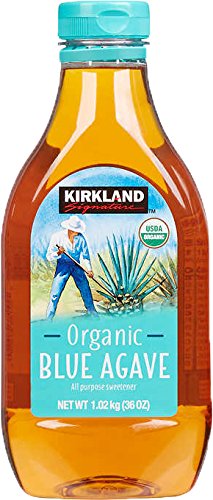
Kirkland Signature Organic Blue Agave is a very solid source of agave nectar thanks to its smooth and golden taste and its organic certification.
The 36 ounce bottles are great for occasional or regular use, and the flip-top cap makes dispensing either a small or large amount of agave nectar easy. Due to all these advantages, it’s our number one pick.
2. Bluava 100% Pure Blue Agave
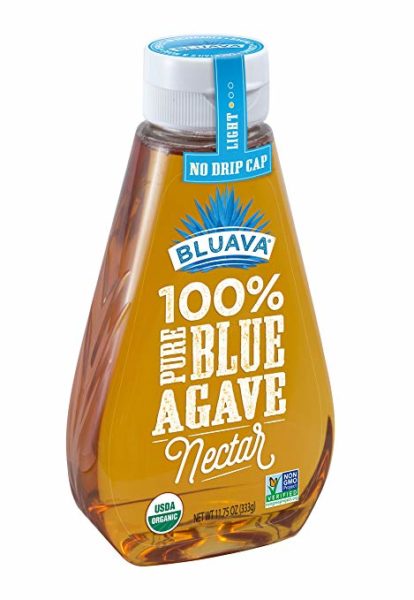
Bluava 100% Pure Blue Agave is an excellent choice if you are looking for a small batch artisanal agave nectar.
This agave nectar is both organically grown and sustainably sourced, so it’s a great eco-conscious choice.
3. Madhava Organic Agave Five

For those who are worried about the high sugar content of regular agave, Madhava Organic Agave Five offers an innovative solution.
It uses natural organic blue agave, combined with stevia and water to create a sweetener that has the flavor profile of agave but only five calories per serving. It’s an excellent option to get the unique flavor profile of agave without all of the calories.
4. Tres Agaves Agave Nectar

Tres Agaves Agave Nectar is an agave nectar made specifically for use in cocktails. It’s diluted slightly with water, so it’s easier to mix into cold alcoholic drinks, and it includes citric acid to make sure the nectar is shelf-stable.
The rich, complex flavor of this agave nectar mixes up very well with tequila and mezcal. You could even try it in spiced hot chocolate or hot apple cider.
5. Madhava Organic Amber Raw Blue Agave

Madhava Organic Amber Raw Blue Agave comes in a large 46 ounce bottle that’s well-suited for regular users of agave or for people who entertain a lot of guests.
The deep red color indicates its rich flavor, which sets it apart from lighter and sweeter-tasting agave nectars.
The occasional user might want to opt for a smaller container, but because of its organic certification, it’s hard to find any flaws with this agave nectar.
6. Nectave Premium Organic Agave Nectar
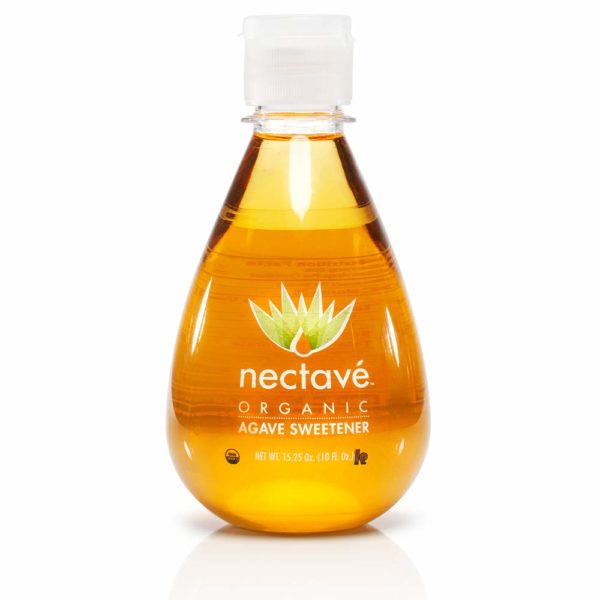
Nectave Premium Organic Agave Nectar is designed for blending specialty tea, coffee, and alcoholic drinks. Its bottle comes equipped with an easy to use pump top that makes dispensing exact serving sizes a breeze.
The rich, deep red agave nectar has a strong flavor profile with no aftertaste, so it blends in very well with top-shelf tea, coffee, or spirits.
7. Wholesome Sweeteners Organic Blue Agave
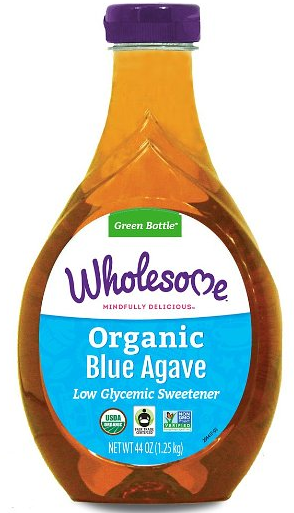
Wholesome Sweeteners Organic Blue Agave is a light, sweet, and smooth agave nectar that comes in a fairly large 44 ounce bottle, so it’s well-suited for large groups.
The organic certification is nice to see, and the light color and smooth flavor will make it an easy transition from people who are used to the sweet but bland flavor profile of table sugar
8. NOW Foods Certified Organic Light Agave Nectar

NOW Organic Light Agave Nectar is organically certified and comes from a family owned and operated business.
The light and sweet nectar comes in a very reasonably-sized 23 ounce bottle, so it’s a great choice for occasional users who don’t need huge containers of agave nectar on the shelf.
9. Agave in The RAW Organic Agave Nectar
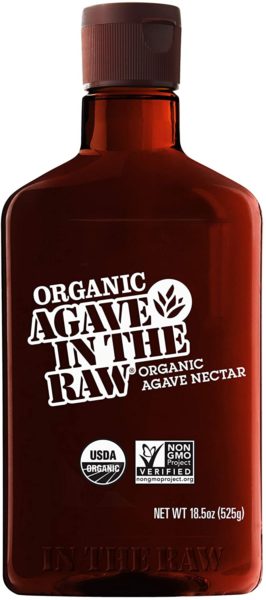
Agave in The RAW is a pretty straightforward and simple agave nectar.
Its light flavor profile is not likely to be off-putting to anyone, and the 18.5 ounce bottle is versatile enough for a variety of users.
Beyond that, there aren’t too many particular features about this agave nectar that set it apart from the crowd.
10. Blue Green Organics Blue Agave
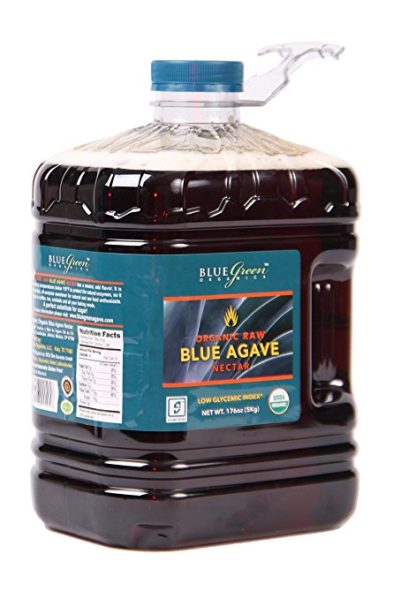
Blue Green Organics Blue Agave comes in a giant five kilogram jug. It’s organically certified, which is great, though for most people, the sheer volume of agave is going to be too much to use in any reasonable amount of time.
Who Should Buy Agave Nectar?
Agave nectar is great for people of all ages looking to add an all natural sweetener to their foods or beverages. It can be better for overweight people since agave nectar has a lower glycemic index than sugar. However, you should keep in mind this high fructose content when considering whether to opt for agave or a different sweetener.
Agave is widely used for mixed drinks, especially ones based on tequila, which is derived from the same plant. For occasional use, agave nectar gives an earthier, more sophisticated flavor to mixed drinks than your average simple syrup.
How We Ranked
Nectar agave comes in raw, light, and dark agave forms. The main difference has to do with the filtration of salts and minerals in the production of the agave, leading to slightly different products. Light agave nectar, like Wholesome Sweeteners and Valor Organic, has a mild, neutral flavor that is great baked some sauces, baked goods, and beverages. The amber grade is similar to honey and is used to sweeten a wide variety of foods, drinks, baked goods, and sauces. These 2 options were the most popular and versatile, making up most of our rankings.
The dark grades of nectar agave are fantastic for heavy sauces like BBQ and meat glazes. Raw agave nectar, like Madhava Organic, has a mild, neutral taste and produced at temperatures below 118°F to protect the natural enzymes. Blue agave nectar, like Blue Green Organics, is nearly identical to other forms of agave nectar (it just comes from a different species called Agave tequilana) and was ranked similarly.
To ensure purity, all the products on our list were grown to USDA organic standards and processed without chemicals or genetic modification. Furthermore, we preferred products like Bluava, that was eco-friendly and sourced in a way that wouldn’t harm the environment.
Category winners
Best agave nectar overall: Kirkland Signature Organic Blue Agave
Kirkland Signature’s agave is 100% pure and certified organic, making it the perfect first pick, whether you’re mixing drinks or baking. With something as simple and pure as this, it’s impossible to go wrong.
Best agave nectar for margaritas: Madhava Organic Amber Raw Blue Agave
For mixing high-quality margaritas, you want your agave to be high quality as well. Madhava fits the bill perfectly, with its 100% pure formulation and bulk size that’s big enough even for large parties.
Best agave nectar for cocktails: Tres Agaves Mixer
Tres Agaves adds a pinch of citric acid alongside the agave nectar to add some extra tanginess to cocktails and mixed drinks. It’s a nice complement to the citrus flavor you’ll likely be adding with lemons or limes.
Best low calorie agave nectar: Madhava Organic Agave Five
Not a fan of the high sugar content of agave nectar? Madhava is a great option: by using stevia alongside natural agave, it drops the caloric content down to only five calories per teaspoon without sacrificing the distinctive taste of agave nectar.
Best bulk agave nectar: Madhava Organic Amber Raw Blue Agave
Coming in a hefty 46 ounce bottle, Madhava provides enough agave nectar for even the heaviest users. Cooking for a big holiday dinner or mixing drinks for a big party will be no problem with this agave nectar.
Best agave nectar for hair: Madhava Organic Amber Raw Blue Agave
Want to get a deep condition for your hair and banish dryness, even from thick curly hair? Madhava might be just what you need. Its 100% pure formulation can help the sugars in agave lock in moisture to your hair, keeping it strong and well-hydrated.
Benefits
Agave nectar is sweeter than sugar, but has more fructose. Agave nectar is a sweetener marketed as a healthy alternative to white sugar, but the high fructose content of this syrup might be bad news for your metabolism.
Finding a consensus among nutritional experts about what’s good for us and what’s not can be challenging, but everyone agrees it’s smart to avoid sugar.
The negative impact of including lots of added sugar in the diet is becoming more widely accepted as the number of people struggling with obesity continues to grow.
The demand for alternative sweeteners has swelled as health-conscious people search for healthier ways to enjoy sweets. Food companies have flooded the market with artificial and natural sweeteners to replace white sugar.
Agave nectar was traditionally used for medicinal and culinary purposes. Native to Mexico and the American southwest, raw agave nectar taken straight from the thick, succulent leaves has been used for hundreds of years by Mexicans as a flavoring for food and drinks; the basis for most modern syrups is the blue agave plant. (1)
By far the most common use of agave nectar is for making tequila; Mexico exported more than 300 million liters of tequila in 2008. (2) The nectar is boiled down and then fermented into an alcoholic drink popular around the world.
Unfortunately, commercial processing used to convert the natural, raw nectar circulating inside firm, plump agave leaves basically strips the substance of most or all of the goodies contained in the original liquid.
Plant leaves are harvested when agave has grown for about 8 to 10 years. These are brought to a processing facility where they are chopped and then pressed to extract the sweet fluid. The liquid is boiled down, filtered and bottled.
While the fructans present in raw agave nectar have been shown to exert positive effects on insulin response and metabolism (3), these are converted into fructose when exposed to heat and enzymes. (4, 5) This is essentially the same formula used for manufacturing high fructose corn syrup.
Some agave nectar products are labeled as “raw,” which means the heat used for processing has been kept below 118 degrees in order to preserve naturally occurring enzymes. This may be a healthier version of agave nectar, but most commercially available nectars would be more appropriately called a syrup.
Agave nectar has a lower glycemic index than sugar. Agave nectar has a lower glycemic index (GI) rating than sugar; GI ratings are based on how much sugar a food releases into the blood. While agave nectar clocks in at 13 (6), sucrose (table sugar) hits the scale at 68. (7)
This lower rating explains why agave nectar is marketed as friendly for diabetics and others with concerns about spiking blood sugar levels. Foods with high GI ratings have been shown to negatively impact health on many levels, including a strong association with obesity. (8, 9, 10)
In animal studies, the metabolic effects of agave nectar compared favorably with the effects of sugar: over a month’s time, mice eating sugar gained more weight and showed higher insulin and blood sugar levels than mice eating agave nectar. (11)
Weight gain is associated with elevated blood sugar and insulin levels, so this isn’t a surprising result for a short-term study.
But it’s important to understand that fructose such as that found in agave nectar affects the body differently than the sucrose and glucose found in table sugar.
Glucose fuels all living cells; healthy foods like potatoes and carrots contain glucose, and this molecule can be metabolized by every cell in our bodies. However, the liver is the only organ with the capacity to metabolize significant amounts of fructose. (12)
Side effects
Because fructose does not get used by most of the cells in the body, the liver is forced to process it. This can lead to some negative metabolic consequences, and the high fructose content of agave has been compared to high fructose corn syrup.
Since most of the fructose you take in must be processed through the liver, it’s vital to know what happens next: the liver converts fructose into fat and ships it out in the form of very low density lipoproteins (VLDL), raising blood triglycerides. VLDL is a subtype of “bad” cholesterol, and VLDL is particularly damaging to cardiovascular health.
VLDL is associated with the formation of plaque that can be deposited on artery walls, which can cause blockage over time. (13) Fructose can also increase low density lipoprotein (LDL) particles, the “bad” cholesterol, and increase accumulation of fat in the abdominal area. (14)
This is bad news for heart health.
Researchers have also found indications that high levels of fructose in the diet may lead to fatty deposits in the liver, which can result in fatty liver disease. (15, 16, 17) Non-alcoholic fatty liver disease often goes undetected until it has progressed to the point where it seriously impacts liver function. (18)
The fructose content of agave nectar runs at about 85%. Subjects who consumed generous amounts of fructose over the long term experienced higher blood sugar and insulin levels (19, 20, 21), which translates to an increased risk of developing type 2 diabetes and metabolic syndrome.
Don’t confuse the small amounts of fructose found in fruits and other whole foods with the concentrated fructose in products like agave nectar.
When you eat apple or another whole fruit, it’s loaded with fiber, which slows down the assimilation of fructose.
Fiber also makes you feel full; you’d have a tough time consuming enough fruit-sourced fructose to impact blood sugar levels the way a fructose-heavy sweetener like agave nectar would.
FAQ
What is agave nectar? Agave is grown worldwide and offers several products from one plant. The flowers, stalks, and even the leaves of agave are edible, but the nectar is the most commonly consumed part of the plant. Agave nectar is essentially the sweet sap that is extracted from the agave plant and used as a sweetener in place of sugar or other types of sweeteners.
What is agave nectar used for? Agave nectar is most commonly used as a natural sweetener and a sugar substitute by those looking to decrease the amount of refined sugar in their current diet. It is usually added to enhance the sweetness of both cold and hot beverages. However, it is also included in several other types of products and can be used as a binding agent for items like granola bars or cereal.
Does agave nectar need to be refrigerated? Agave nectar does not need to be refrigerated to preserve quality and taste, though you can refrigerate it if that is your personal preference. Because of agave nectar’s thicker consistency, refrigeration may temporarily thicken the substance further and make it more difficult to use. In general, it is safe to store agave nectar in a pantry even after opening and using the bottle.
Is agave nectar the same as agave syrup? While they are very similar products, agave nectar and agave syrup are not the same thing. The production of agave nectar is very similar to that of retrieving sap from a tree. Agave nectar comes directly from the agave plant, which is then heated to purify the solution. Like maple syrup, agave syrup is created through further heating and treatment of the original product, the sap.
What are the side effects of agave nectar? Most of the side effects connected to the consumption of agave nectar are due to consuming larger amounts of the sweetener or consuming the sweetener long-term. Agave nectar has relatively high levels of fructose in it, which is a type of sugar that the body has trouble digesting in large amounts. With prolonged consumption, this may increase body fat levels and contribute to insulin resistance in users.
Is agave nectar keto? While you can consume agave nectar on the keto diet, it is not recommended for those serious about the diet and achieving the health benefits associated with the diet. Not only does agave nectar have about 5 grams of carbohydrates per serving, but agave nectar is also basically sugar. Agave nectar does not have the same glycemic index of sugar, but it does promote some of the same effects that sugar has on the body. For a person on a keto diet looking to limit their carbohydrates and sugar intake, agave nectar should be avoided.
Is agave better than stevia? Unlike agave, stevia has zero calories per serving, making it a great choice for those looking to lose weight or cut calories. Stevia does not contribute to a spike in blood pressure after consumption, but agave causes a slight increase in blood sugar levels. Overall, stevia is the better choice when it comes to sweetener, as it has zero calories and also does not affect blood sugar levels at all.
What are the benefits of using agave nectar? Agave nectar is generally viewed as a relatively healthy additive and a solid sugar substitute for those looking to reduce sugar intake. Agave nectar has a glycemic index of 19, which is significantly lower than a glycemic index of about 60, which is found in regular table sugar. This makes agave nectar a safer alternative for those with unstable blood sugar levels. Some have theorized that using agave nectar on the skin results in anti-aging effects as well as bacteria reduction. These claims reach back thousands of years to the ancient Aztec population. One study suggests that, when compared to other natural types of sugar (sucrose), agave nectar has a greater influence on weight maintenance and glucose levels within the blood. There seems to be a connection between the consumption of agave and a reduction in body fat and body weight. Another study connects the consumption of agave to a possible prebiotic effect. Prebiotics have an incredible effect on the gastrointestinal system, specifically increasing healthy bacteria to promote overall gut health (22, 23).
Is agave nectar good for weight loss? The effects of the agave plant have been studied more in-depth as of late, and some studies have determined a connection between agave consumption and body weight. One recent study proved that agave could be a great addition to a diet for those looking to lose weight. When agave was consumed consistently by obese individuals consuming a low-calorie diet, there was a marked effect on their body weight, body fat, BMI, and even triglyceride levels. After a 12 week period, scientists noted that the group consuming the agave lost about 10% of their body fat (24).
When was agave nectar discovered? Though agave nectar has only recently become extremely popular among those looking to improve their health, agave nectar has been used for several thousand years. There is evidence that humans were consuming and using the agave plant over 10,000 years ago. By the 1500s, those in Mexico began using one species of the agave plant to begin producing tequila.
What are the culinary uses of agave nectar? Agave nectar has a wide range of culinary uses, though the most common usage of agave nectar is to sweeten hot or cold beverages (similar to honey). Agave nectar is also a common ingredient in many alcoholic beverages, particularly tequila, rum, and whiskey. Many have discovered that agave nectar can be used to replace many baking ingredients to reduce the levels of actual sugar in the food. Agave nectar can replace corn syrup, brown rice syrup, honey, and even dried forms of sugar. Essentially, agave nectar can be used as a substitute for any syrup or sweetener, though this might require slight modifications in the recipe.
Is agave syrup a safe sweetener for a Type II Diabetic? If you’ve been diagnosed with diabetes, then you know that consuming foods with a low glycemic index are in your best interest. With that said, agave syrup has a glycemic index of 19, which is extremely low when you consider the fact that table sugar has a glycemic index of over 60. Agave nectar and agave syrup are therefore great substitutes for sugar if you have diabetes, as the substances will not cause as drastic of an increase in your blood sugar levels after consumption. However, since agave has high levels of fructose, you should only consume agave in limited amounts to prevent detrimental effects to your health.
Is agave nectar vegan? Agave nectar is considered vegan, as it comes directly from a plant.
What is a substitute for agave nectar? Agave nectar can be replaced easily if you are looking to utilize another sweetener. If your ideal sweetener has a syrup-like consistency, you could use brown rice syrup, maple syrup, or honey in place of agave nectar. If you are simply looking to sweeten a beverage, there are plenty more options, such as those listed previously as well as natural sweeteners like xylitol or erythritol. Ultimately, you can replace agave nectar with nearly any sweetener on the market.
Is agave nectar anti-inflammatory? There is some evidence that the agave plant itself has some anti-inflammatory qualities, however, it is very likely that these qualities are lost during the processing of agave nectar. It would not be accurate to state that agave nectar is anti-inflammatory, but this is something that scientists are currently studying to learn about all of the potential health benefits of agave and agave nectar (25).
What is the shelf life of agave nectar? Agave nectar will stay fresh for more than a year when unopened. It should be stored in a cool dark place to maintain color and consistency.
What is the difference between the light, dark, and raw agaves? The main difference has to do with the filtration of salts and minerals in the production of the agave, leading to slightly different products. Raw has a neutral, sweet flavor that is great as a topping on pancakes. The lighter grades of Agave Nectar are more neutral, enhancing the natural flavors of various foods and drinks without altering heir flavor – which makes it a better alternative to honey, which often changes the taste. The amber grade is similar to honey and is used to sweeten a wide variety of foods, drinks, baked goods, and sauces. The dark grades of nectar agave are fantastic for heavy sauces like BBQ and meat glazes.
What is agave nectar traditionally used for? Traditionally, agave nectar was used for culinary and medicinal purposes. It’s native to Mexico and dates back to hundreds of years of use, flavoring various foods and drinks in their culture. Today it’s often used as a syrup, binding agent, or flavor enhancer.
What is the most common use of agave nectar? The most common use of agave nectar is for making tequila. To make tequila from agave, you must first boil and then ferment the nectar.
How long does the agave plant need to grow before being harvested? Agave needs to grow for about 9 years before the plant leaves can be harvested and then pressed to extract the sweet fluid.
What does raw agave nectar mean? “Raw” agave nectar means that the heat used during processing was kept below 118 degrees in order to preserve naturally occurring enzymes. It is believed this makes the nectar healthier, but it’s up for debate.
Does agave next have a high GI score? No, in face agave nectar has a lower GI score than sugar, clocking in at 13 versus sugars 68. This is why agave nectar is suitable for diabetics. Foods with a high GI score have been shown to promote obesity in the long run and are unhealthy for humans.
Is fructose different than glucose? Yes, while they are both sugars, they act very differently in the body. Fructose can only be metabolized by the liver, whereas glucose can be used by every living cell in the body. AS such, your body can tolerate a lot less fructose, making fructose potentially dangerous at high levels of consumption.
Is fructose bad for you? In excessive amounts, fructose can be bad for you since it can only be processed in the liver. This can lead to some negative metabolic consequences since the liver converts fructose into fat in the form of very-low-density lipoproteins. The fructose content of agave nectar runs at about 85% who cons and persons who consume large amounts of fructose over the long term experience higher insulin levels, which can lead to an increased risk of developing type 2 diabetes.
What are very-low-density lipoproteins (VLDL)? VLDL is a subtype of bad cholesterol, and VLDL is particularly damaging to cardiovascular health. VLDL is associated with the formation of plaque that can be deposited on artery walls, which can cause blockage over time.
Does fructose cause NAFLD? Researchers have also found indications that high levels of fructose in the diet may lead to fatty deposits in the liver, which can result in fatty liver disease. Non-alcoholic fatty liver disease often goes undetected until it has progressed to the point where it seriously impacts liver function.
Is the fructose in fruit the same as agave nectar? While they are the same, it is an unfair comparison, because the amounts are staggeringly different. Furthermore, fruit contains fiber, which slows down the release of sugar in the body, lessening the impact on blood sugar levels and insulin.
Related Articles
Recap
We all know sugar is bad for us, and cutting back or eliminating sugar is a wise move. Staying away from artificial sweeteners might also be smart, since some act as neurotoxins and can compromise health in new and interesting ways.
Approaching alternative sweeteners with caution is also a good idea, since much of what’s available today is no better than sugar, and some are worse, including agave nectar.
If you have a stubborn sweet tooth that can’t be tamed, consider checking out xylitol, erythritol or stevia. Because agave nectar derives its sweet flavor primarily from fructose, consuming it regularly in generous amounts is likely to undermine your health, but that does not mean it can’t be used as a natural sweetener in small amounts. You just need to be mindful of the amount of agave nectar you are consuming, and how often you are consuming it.
For Body Nutrition’s #1 agave nectar recommendation, click here.